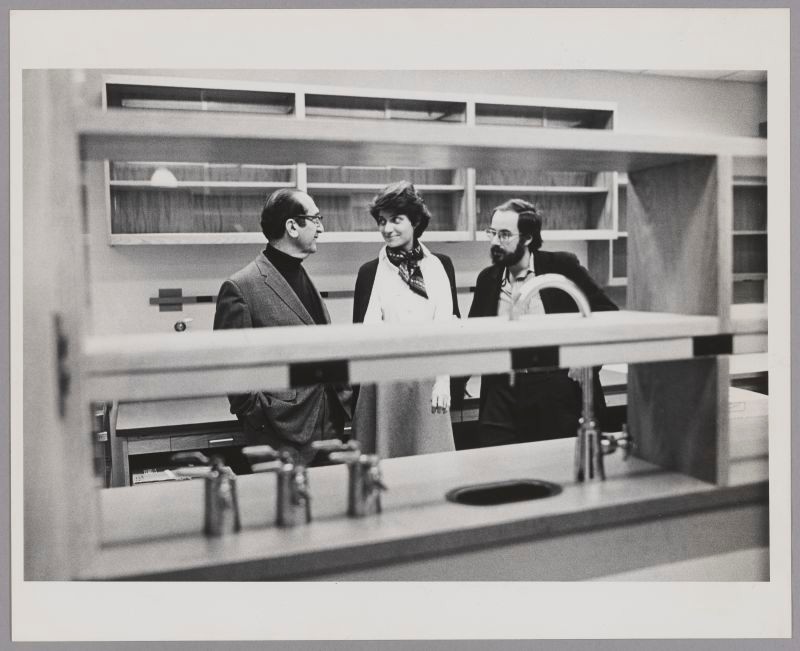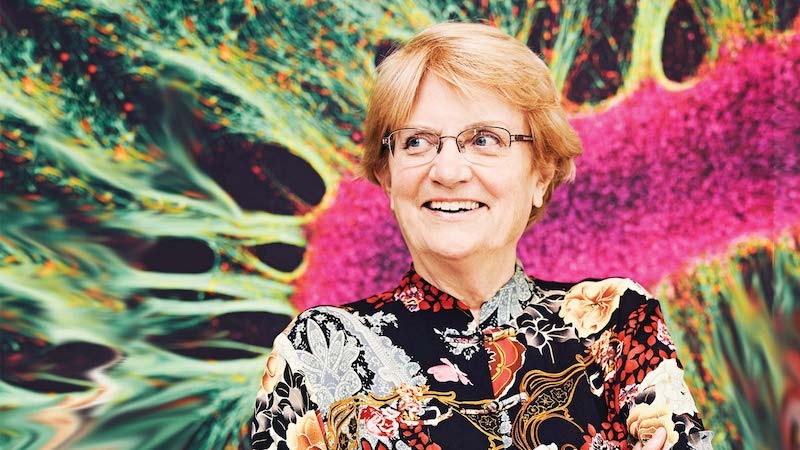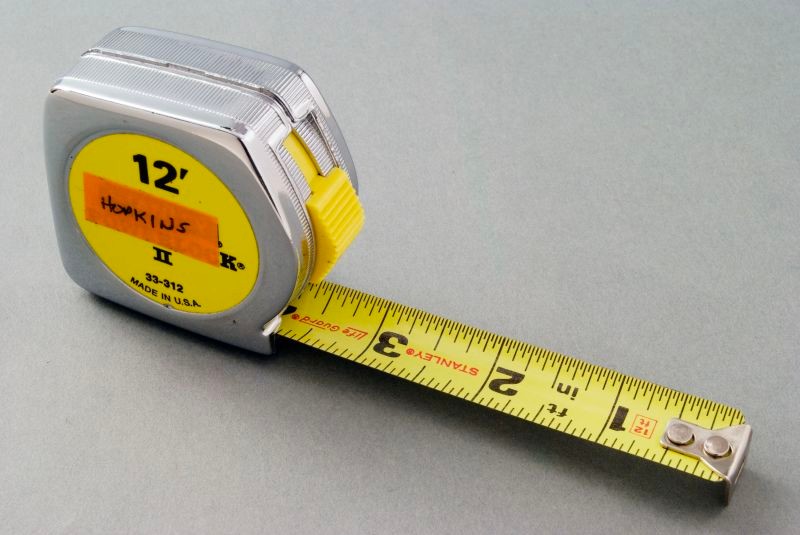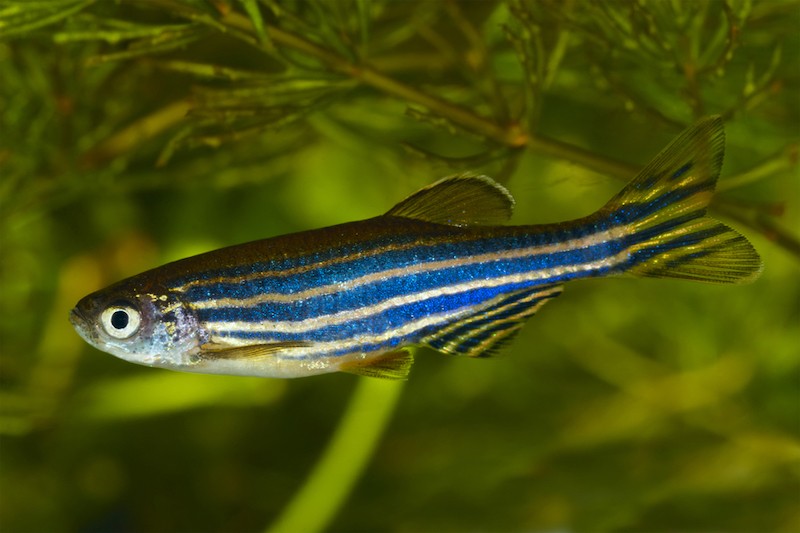Site of Nancy Hopkins' Original Laboratory: Seeley G. Mudd Building (E17)
Introduction
Text-to-speech Audio
Nancy Hopkins joined MIT’s Center for Cancer Research, then housed at the Seeley Mudd Building (E17), as an assistant professor in 1973 and earned tenure in 1979.10,11 Now the Amgen Inc. Professor of Biology Emerita, Nancy pioneered work on the genetics of mouse RNA tumor viruses, early vertebrate development using zebrafish, and on zebrafish as a cancer model. In 1994, armed with a tape measure and laboratory floorplan, she launched an investigation that would change the work environment for women at MIT and across the country.
When the Cancer Center moved across the street to The David H. Koch Institute for Integrative Cancer Research (Building 76) in 2010, MIT renovated Buildings E17 and E18 to provide additional space for the Chemical Engineering department and other projects on campus.3,15 E17 is Key Card Access only.
For guidance on accessing MIT Buildings visit https://now.mit.edu/policies/campus-access-and-visitors/
Images
Nancy Hopkins with Salvador Luria & David Baltimore (1974?)

Nancy Hopkins, Amgen Professor of Biology Emerita.

“Stanley "Power Lock II" 12' tape measure.” - The tape measure that changed the world

Zebrafish

Backstory and Context
Text-to-speech Audio
After listening to a lecture by James Watson on the discovery of DNA’s double helix structure and its potential to unlock the mystery of cancer during her junior year, Nancy Hopkins immediately applied for a job with Watson’s research team and was accepted. Kate Zernike writes, during this time, “Nancy saw how small facts from individual experiments added up to larger insights that could answer big questions.”18 Determined to learn why some cells turned cancerous, Nancy earned her Ph.D. in Molecular Microbiology from Harvard in 1971. Months later, President Richard M. Nixon signed the National Cancer Act of 1971, establishing 15 new cancer research facilities — including one at MIT.9,18
Scientists compete not only to be the first to publish discoveries but also for funding, laboratory space, equipment, and teaching assignments. But by 1994, Nancy suspected that a canceled teaching assignment and persistent space and funding inequities indicated the setbacks she experienced represented more than competition among colleagues.
As a Scientist, Nancy looked for data to test her hypothesis. She surreptitiously measured the square footage of her colleagues' laboratories and offices and correlated the data with rank and gender. Nancy found that as a senior tenured woman, she had less lab space than her junior male colleagues. Shocked and angry, Nancy drafted a letter to MIT President Charles Vest. Before sending it, she shared the letter with Mary Lou Pardue, another tenured professor in her department. Inspired by their shared experiences, Nancy and Mary Lou informally surveyed other tenured women from the School of Science. Of the 17 women, all but one acknowledged experiencing gender-based discrimination. Together, they approach the Dean of the School of Science, Robert Birgeneau. The women’s collected data and experiences revealed a disturbing pattern of gender discrimination and supported their request for a formal study of the issues. After much effort, the School of Science appointed a committee of six women and three men, chaired by Nancy, “to collect data to be used in assessing the status and equitable treatment of women faculty in the School of Science.”12,18
Although the original report remains confidential, the committee summarized their findings for the March 1999 Faculty Newsletter, “[While junior women faculty feel well-supported,] many tenured women faculty feel marginalized and excluded from a significant role in their departments. Marginalization increases as women progress through their careers at MIT. Examination of data revealed that marginalization was often accompanied by differences in salary, space, awards, resources, and response to outside offers between men and women faculty with women receiving less despite professional accomplishments equal to those of their male colleagues.”2
In the preface, MIT President Charles Vest praised the study urging all MIT Faculty to read it and take action. “I learned two particularly important lessons from this report and from discussions while it was being crafted. First, I have always believed that contemporary gender discrimination within universities is part reality and part perception. True, but I now understand that reality is by far the greater part of the balance. Second, I, like most of my male colleagues, believe that we are highly supportive of our junior women faculty members. This also is true. They generally are content and well supported in many, though not all dimensions. However, I sat bolt upright in my chair when a senior woman, who has felt unfairly treated for some time, said ‘I also felt very positive when I was young.’"2
The Boston Globe’s Kate Zernike would be the first to break the story, followed by the New York Times’ Carey Goldberg and other national and international media outlets.4,18 This “stunningly candid and publicly released report detailing gender inequity at MIT — and Vest’s subsequent leadership on the issue —stimulated examination of gender equality at universities across the country.”7,17 Other colleges and universities would follow MIT’s lead.
In the early 1970s, when Nancy and Mary Lou began work at MIT, women represented 10% of US doctorates and 2% of MIT’s Faculty.6,8 Fifty years later, According to the Pew Research Center, women earn the majority of doctorates yet remain underrepresented with STEM research doctorates in all but the Life Sciences. As of 2022, 25% of MIT’s Faculty are women.5,13
Nancy’s research came full circle when it led to the discovery of genes predisposing fish to cancer. In 2008, Nancy was diagnosed with cancer, describing it as “one of the most interesting scientific experiences of [her] life.”1 She saw how the work she had helped pioneer supported the identification of viruses that caused cancer and the development of anti-cancer vaccines. Today, Hopkins works on advocacy for cancer prevention and early detection research.1,16
Sources
- “A Conversation with Nancy Hopkins.” MIT Department of Biology, YouTube, 18 May 2011. https://www.youtube.com/watch?v=4GAGSBbuqX0. Accessed 29 Mar. 2023.
- “A Study on the Status of Women Faculty In Science at MIT.” MIT Faculty Newsletter, Special Edition, Vol. XI No. 4., Mar. 1999, http://web.mit.edu/fnl/women/women.html. Accessed 1 Apr. 2023.
- “Buildings E17 and E18 Renovation.” Capital Projects | Massachusetts Institute of Technology, https://capitalprojects.mit.edu/projects/buildings-e17-and-e18. Accessed 21 Apr. 2023
- Colwell, Rita, and Sharon Bertsch McGrayne. A Lab of One’s Own. Simon and Schuster, 2020.
- “Diversity Dashboard — MIT Institutional Research.” MIT Institutional Research, 2023, https://ir.mit.edu/diversity-dashboard. Accessed 1 Apr. 2023.
- Dresselhaus, Mildred S., and Paula J. Stone. Ad Hoc Committee on the Role of Women Students at MIT Report. Prepared for Dean for Student Affairs, Massachusetts Institute of Technology, 1972.
- "Former MIT President Charles M. Vest Dies at 72,” MIT News, December 13, 2013. http://web.mit.edu/newsoffice/2013/former-mit-president-charles-m-vest-dies-at-72-1213.html. Accessed 7 Apr. 2023.
- Graham, Patricia Albjerg. “Women in Academe, ”SCIENCE, 25 Sep 1970, Vol 169, Issue 3952, pp. 1284-1290. https://www.science.org/doi/10.1126/science.169.3952.1284. Accessed 31 Mar. 2023. [DOI: 10.1126/science.169.3952.1284] This article generated the letter from Magasanick, “Women Please Apply,” in Feb. 1971.
- “Impact of 1971’s National Cancer Act Marked | NIH Record.” NIH Record, 10 Dec. 2021. https://nihrecord.nih.gov/2021/12/10/impact-1971s-national-cancer-act-marked. Accessed 7 Apr. 2023.
- MIT Reports to the President 1973. https://libraries.mit.edu/archives/mithistory/presidents-reports/1973.pdf. Accessed 31 Mar. 2023.
- MIT Reports to the President 1979. https://libraries.mit.edu/archives/mithistory/presidents-reports/1979.pdf. Accessed 31 Mar. 2023.
- MIT Reports to the President 1995. https://libraries.mit.edu/archives/mithistory/presidents-reports/1995.pdf#page=404. Accessed 23 Apr. 2023.
- Nadeem, Reem. “STEM Jobs See Uneven Progress in Increasing Gender, Racial and Ethnic Diversity | Pew Research Center.” Pew Research Center Science & Society, 1 Apr. 2021, https://www.pewresearch.org/science/2021/04/01/stem-jobs-see-uneven-progress-in-increasing-gender-racial-and-ethnic-diversity/. Accessed 6 Apr. 2023.
- “Nancy Hopkins, Amgen Professor of Biology Emerita.” MIT Department of Biology, 2019. https://biology.mit.edu/profile/nancy-hopkins/. Accessed 29 Mar. 2023.
- “The David H. Koch Institute for Integrative Cancer Research at MIT, Building 76.” Capital Projects | Massachusetts Institute of Technology, https://capitalprojects.mit.edu/projects/koch-institute-building-76. Accessed 21 Apr. 2023.
- Trafton, Anne. “3Q: Nancy Hopkins on the Impact and Potential of Cancer Prevention | MIT News | Massachusetts Institute of Technology.” MIT News | Massachusetts Institute of Technology, 25 June 2018, https://news.mit.edu/2018/3q-nancy-hopkins-impact-and-potential-cancer-prevention-0625. Accessed 7 Apr. 2023.
- “Tribute to Pres. Charles M Vest | Tribute to President Charles M Vest.” Tribute to Pres. Charles M Vest | Tribute to President Charles M Vest, https://wgsvesttribute.mit.edu/. Accessed 7 Apr. 2023.
- Zernike, Kate. The Exceptions. Simon and Schuster, 2023.
1. Nancy Hopkins with Colleagues, Courtesy of the MIT Museum. https://mitmuseum.mit.edu/collections/object/GCP-00034268. Accessed 23 Apr. 2023.
2. Nancy Hopkins, MIT Department of Biology. https://biology.mit.edu/profile/nancy-hopkins/. Accessed 31 Mar. 2023.
3. Tape Measure. Courtesy of the MIT Museum. https://mitmuseum.mit.edu/collections/object/2012.026.001. Accessed 23 Apr. 2023.
4. “Study: Zebrafish are smarter than we thought.” MIT News, 18 Nov. 2022. https://news.mit.edu/2022/smarter-zebrafish-study-1118. Accessed 23 Apr. 2023.
